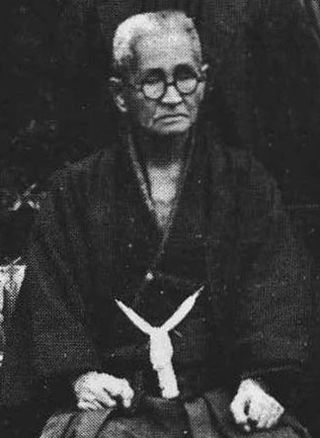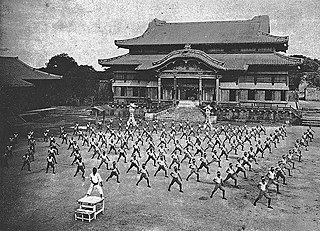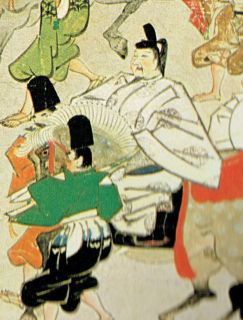You can help expand this article with text translated from the corresponding article in Japanese. (July 2021)Click [show] for important translation instructions.
|
Chōtoku Tanaka (田中 長徳, Tanaka Chōtoku, born 1947) is a Japanese photographer. [1]
You can help expand this article with text translated from the corresponding article in Japanese. (July 2021)Click [show] for important translation instructions.
|
Chōtoku Tanaka (田中 長徳, Tanaka Chōtoku, born 1947) is a Japanese photographer. [1]

Kakuei Tanaka was a Japanese politician who served in the House of Representatives from 1947 to 1990, and was Prime Minister of Japan from 1972 to 1974.

Nihon University, abbreviated as Nichidai (日大), is a private research university in Japan. Its predecessor, Nihon Law School, was founded by Yamada Akiyoshi, the Minister of Justice, in 1889. It is one of Japan's leading private universities. The university's name is derived from the Japanese word "Nihon" meaning Japan. Nihon University now has "16 colleges and 87 departments, 20 postgraduate schools, 1 junior college which is composed of 5 departments, 1 correspondence division, 32 research institutes and 3 hospitals." The number of students exceeds 70,000 and is the largest in Japan.
Tanaka (たなか) is the fourth most common Japanese surname. It is typically written with the kanji for ricefield & middle (田中). Less common variants include many & middle (多中), many & relationship (多仲), another & middle (他中), shelf & low (棚下), shelf & summer (棚夏) and many & name & congratulation (多名賀).
Kai Doh Maru is an original video animation (OVA) anime directed by Kanji Wakabayashi and produced by Production I.G. and SME Visual Works. It was released on December 19, 2001 in Japan and on July 29, 2003 in the United States by Manga Entertainment. In Australia, it is distributed on DVD by Madman Entertainment.

Fujiwara no Michitaka, the first son of Kaneie, was a Kugyō of the Heian period. He served as regent (Sesshō) for the Emperor Ichijō, and later as Kampaku. Ichijō married Michitaka's daughter Teishi (Sadako), thus continuing the close ties between the Imperial family and the Fujiwara.

Chōtoku (長徳) was a Japanese era name after Shōryaku and before Chōhō. This period spanned the years from February 995 through January 999. The reigning emperor was Ichijō-tennō (一条天皇).

Chōhō (長保) was a Japanese era name after Chōtoku and before Kankō. This period spanned the years from January 999 through July 1004. The reigning emperor was Ichijō-tennō (一条天皇).
Kosaku Matsumora was a Ryūkyūan karate master. He studied Tomari-te under Karyu Uku and Kishin Teruya. He also studied Jigen-ryu. Among Matsumora's students, who went on to influence new generations through students of their own, were Choki Motobu and Chotoku Kyan.

Chotoku Kyan was an Okinawan karate master who was famous for both his karate skills and his colorful personal life. He had a large influence on the styles of karate that would become Shorin-Ryu and its related styles.
Shōbayashi Shōrin-ryu (少林流) is a style of Okinawan Shorin-ryu karate founded by Eizo Shimabukuro. Eizo Shimabukuro (1925-2017) dropped the Chatan Yara no Kusanku and the Oyadamari no Passai he learned from Chotoku Kyan and he added Kusanku Sho and Dai and Passai Sho and Dai of Yasutsune Itosu lineage. It is said that Eizo Shimabukuro learned these Itosu kata as well as Pinan Shodan to Godan and Naihanchin Shodan to Sandan from Choshin Chibana. However, in his book "Okinawa Karatedo Old Grandmaster Stories" Eizo Shimabukuro says that Chibana was too old to teach and so Chibana referred Shimabukuro to his senior student, Nakazato, for instruction. Eizo Shimabuku also added two kata from his time in Goju-ryu with Chojun Miyagi. These kata being Seiyunchin and Sanchin. At one time Shimabuku taught Shorin-ryu and Goju-ryu side by side.

Okinawan martial arts refers to the martial arts, such as karate, tegumi and kobudō, which originated among the indigenous people of Okinawa Island. Due to its central location, Okinawa was influenced by various cultures with a long history of trade and cultural exchange, including Japan, China and Southeast Asia, that greatly influenced the development of martial arts on Okinawa.

Masahiro Tanaka is a Japanese professional baseball player for the Tohoku Rakuten Golden Eagles of Nippon Professional Baseball (NPB). From 2007 through 2013, he played for the Eagles in NPB. Tanaka was posted by the Eagles after the 2013 season to be signed with the New York Yankees in Major League Baseball (MLB) and signed a seven-year, $155 million contract, the fifth-largest deal ever given to a pitcher at the time. He made his major league debut in 2014 and played for the Yankees through the 2020 season, before deciding to return to Japan.
Kōjō Tanaka was a renowned Japanese photographer.
Kōtarō Tanaka was a Japanese amateur photographer particularly noted for his photography of Osaka and his use of color.
Tokutarō Tanaka was a Japanese photographer.
Shin'ichi Tanaka was a renowned Japanese photographer active in the 1930s.

Fujiwara no Korechika, the second son of Michitaka, was a kugyo of the Heian period. His mother was Takashina no Takako, also known as Kō-no-Naishi (高内侍). His sister Teishi (Sadako) was married to Emperor Ichijō, and Korechika aspired to become the regent (Sessho) for his young brother-in-law after his father's death. Korechika's ambitions pitted him against his powerful uncle, Fujiwara no Michinaga, and the resulting power struggle continued until Empress Teishi's unexpected death. This left Michinaga's daughter, Shoshi, as Ichijō's sole empress, solidifying Michinaga's power at court.
House of Wedlock a.k.a. Hour of Wedlock is a 1986 Japanese film directed by Kichitaro Negishi.

In intentional camera movement (ICM), a camera is moved during the exposure for a creative or artistic effect. This causes the image points to move across the recording medium, producing varied effects such as streaking, textures, and layers in the resulting image. The central idea in ICM photography is that motion serves as the primary compositional element. Strict technical or definitional arguments remain vague in this form of photography which has a long history and is connected with many other forms of photography, such as Impressionism and often blurs genres and styles.
Kōtarō Tanaka may refer to: